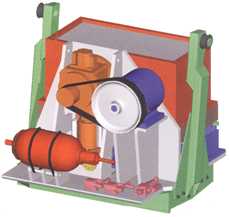| enginuity |
|
All shook up
The devastating consequences of earthquakes on buildings and other civil engineering structures are all too often seen on our television screens. One of the common features of regions where such devastation occurs is the presence of layers of wet, sandy soil below structural foundations, e.g. where building has been carried out on reclaimed land or old riverbeds. 'When subjected to the shaking associated with an earthquake, layers of wet, sandy soil lose all their strength and behave effectively like jelly,' explains Dr Gopal Madabhushi of the Soil Mechanics group. 'Sedimentary layers such as this are often found under the structural supports of bridges which span rivers, and this can cause major problems. For instance, in the 1989 earthquake in the Philippines, about 20 bridges were lost.'
Centrifugal modelling
To design against this type of failure, information is required on the stresses generated by the earthquake. This can be collected either by instrumenting a real structure such as a bridge and waiting for an earthquake to happen, or by instrumenting a small-scale model of the structure and shaking the model in a scientifically controlled way. The latter approach is taken by Dr Madabhushi's team by using the 10-metre Beam Centrifuge out at the West Cambridge site.
A centrifuge allows a small model to mimic the behaviour of a much larger sample of soil. For example, a model 0.5m deep, spun at 100 gravities behaves as if it is 100 times as deep, i.e. it mimics a soil sample 50m deep.
An earthquake has a fundamental frequency of about 1 cycle per second (1Hz), but for dynamic similarity at 100G, the model has to be shaken at 100Hz and the force required is a function of the mass of the model and the severity of the required shake. At 100G, a 40% quake on a 350kg model requires a shake force of 14 tonnes. A typical 'earthquake' involves 10 identical sinusoidal shakes, and lasts 1/10th of a second. By applying a series of sinusoidal shakes at different frequencies, the natural frequency and strength of the soil layers can be determined.
The problem of how to deliver a 14-tonne shake to the model when it is flying around in a centrifuge at lOOG created a research project itself, this time for the design engineers in the Engineering Department. Samuel Lesley, who masterminded this task explains, 'The key to success was the design of a clutch which was big enough to deliver the force, yet small enough to be activated in the time it takes to do one shake at 100Hz (10msec).' The result is a device known as the Stored Angular Momentum (SAM) shaker. This device, which is shown in the accompanying figure, allows the amplitude, frequency and duration of the shake to be varied. The energy for the earthquake comes from two high-speed flywheels rotating at up to 6,000rpm.

The SAM shaker MK2, designed using ProENGINEER software and manufactured in the Engineering Department workshops, using the recently installed CAD/CAM manufacturing capability. The model and its SAM actuator are carried on a swing (shown in green). The assembly swings out during flight on a beam centrifuge. The energy in the high-speed flywheels is momentarily coupled to the model via a high-speed hydraulic clutch, giving the model a powerful but short earthquake.
Positive results
The SAM actuator has met all its design targets and has been in action for over a year. It has already been used to prove the effectiveness of Dr Madabhushi's design for earthquake-resistant bridges. 'We were able to show that bridges were more likely to survive liquefaction of their foundations if the length of span is increased to an optimal amount.' By increasing the span, the weight carried by each support is increased, which makes the soil under the support behave more rigidly during an earthquake. This design information won Dr Madabhushi a prize awarded by the Institution of Civil Engineers for the government of the Philippines in competition with 40 civil engineering companies. 'Our success came through looking at what was happening in the soil beneath the foundations, reducing the effects of that by design and proving the efficiency of design methods with the help of the centrifuge, rather than trying to make bridges which would withstand a possible 2m of movement, which is an almost impossible task.'
For further information, please contact: Mr Samuel Lesley, tel: 01223 332926 or Dr Gopal Madabhushi, tel: 01223 337108.
| number 7, December '98 |